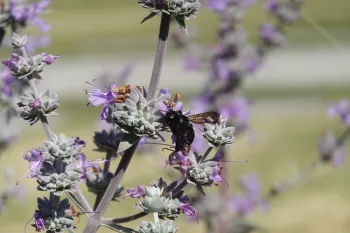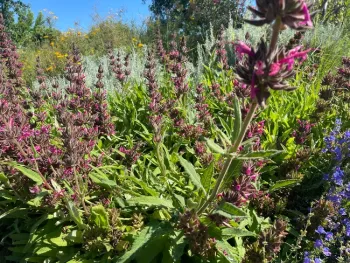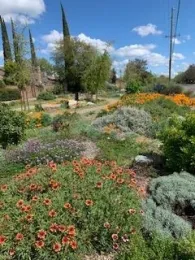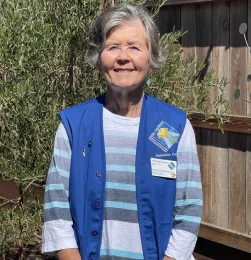
Native California Salvias
Native salvia foliage are known for their distinctive fragrances, often with grayish square stems, and colorful two-lipped flowers arranged in whorls or spikes on flower stalks. The flowers generally come in shades of blue, purple, lavender, with some white, red, and pinks. These salvias grow best in areas with full sun and good drainage. Prune lightly during the growing season, after flowering, to shape the plants. Once established the California native salvias generally need little to no water during the hot months.
Salvia 'Bee's Bliss' (S. ‘Bee's Bliss')

California White Sage (S.apiana)
A semi-deciduous, aromatic bush that grows 3-5 feet tall and 5-8 feet wide. Leaves are silver-white with clusters of small white flowers with lavender streaks that bloom from spring into fall. In Latin, apiana means of or belonging to bees; the white sage is particularly attractive to bumblebees and carpenter bees, as well as hummingbirds. Attractive at night, it reflects the moon and garden lighting. White sage is drought-adapted, low-water shrub that grows best in full sun. Light pruning helps keep it neat and compact. Considered a sacred plant by Native American people, it has been used for hundreds of years for spiritual and medicinal practices.
Black Sage (S. mellifera)

Cleveland Sage (S. clevelandii)
An evergreen shrub from southern California and northern Baja California, this rounded bush grows to 3-5 feet tall and 5-8 feet wide. The leaves are 2 inches, wrinkled, toothed, gray-green elliptical shaped and can perfume the entire garden particularly in the morning, after a rainstorm, or on a warm, summer afternoon. The inch-long pale lavender to violet-blue fragrant flowers are widely spaced whorls along 1.5-2 feet stems. Blooms in the spring through the summer. Remove faded spikes to encourage rebloom. Very drought tolerant; limit watering to no more than once a month during the summer. Several cultivars are available in plant nurseries including the “Winnifred Gilman” variety which is more compact (3 feet wide and tall). The foliage makes a refreshing tea and is also used as a preservative in potpourri.
Hummingbird Sage (S. spathacea)
As the common name suggests, this salvia is a magnet for hummingbirds, but also for bees and butterflies. Native to the low elevation of the coast range of California, it grows 1-2 feet high to 1-3 feet wide. It spreads by rhizomes, so it can cover a wide area, which makes it a popular groundcover plant. The foliage is evergreen, with scalloped, wrinkled leaves, and has a light, fruity aroma. The striking blooms are 2-inch bold pink and magenta whorls which rise above the leaves. It blooms throughout late winter, spring, and summer, and sometimes even into fall with the flowers remaining conspicuous long after they fade. It grows well in partial shade and shade. It is drought-tolerant and can grow without summer irrigation once established, though some supplemental water will keep the foliage green.
So, if you are looking for an easy-to-care-for plant which are highly aromatic, grow well in our hot, often dry climate that will attract a diversity of pollinators, and come in a wide variety of sizes, shapes, and colors to suit any preference you have, consider planting a salvia (or several!).

Resources
- https://ipm.ucanr.edu/PMG/GARDEN/PLANTS/salvia.html
- Sunset Western Garden Book
- California Native Plant Society - https://calscape.org/ (enter “salvia” in the search mode)
Denise Godbout-Avant has been a UC Cooperative Extension Master Garden in Stanislaus County since 2020.

